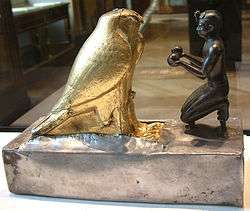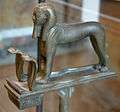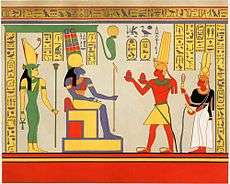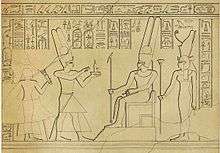Taharqa
| Taharqa | |||||||||||||||||||||||||||||||||||||||||||||||||||||||||||||||||||||||||||||||||||||||||||||||||
|---|---|---|---|---|---|---|---|---|---|---|---|---|---|---|---|---|---|---|---|---|---|---|---|---|---|---|---|---|---|---|---|---|---|---|---|---|---|---|---|---|---|---|---|---|---|---|---|---|---|---|---|---|---|---|---|---|---|---|---|---|---|---|---|---|---|---|---|---|---|---|---|---|---|---|---|---|---|---|---|---|---|---|---|---|---|---|---|---|---|---|---|---|---|---|---|---|---|
 Granite sphinx of Taharqa from Kawa in Sudan | |||||||||||||||||||||||||||||||||||||||||||||||||||||||||||||||||||||||||||||||||||||||||||||||||
| Pharaoh | |||||||||||||||||||||||||||||||||||||||||||||||||||||||||||||||||||||||||||||||||||||||||||||||||
| Reign | 690–664 BCE (25th dynasty) | ||||||||||||||||||||||||||||||||||||||||||||||||||||||||||||||||||||||||||||||||||||||||||||||||
| Predecessor | Shebitku | ||||||||||||||||||||||||||||||||||||||||||||||||||||||||||||||||||||||||||||||||||||||||||||||||
| Successor | Tantamani | ||||||||||||||||||||||||||||||||||||||||||||||||||||||||||||||||||||||||||||||||||||||||||||||||
| |||||||||||||||||||||||||||||||||||||||||||||||||||||||||||||||||||||||||||||||||||||||||||||||||
| Consort | Great Queen Takahatenamun, Atakhebasken, Naparaye, Tabekenamun[2] | ||||||||||||||||||||||||||||||||||||||||||||||||||||||||||||||||||||||||||||||||||||||||||||||||
| Children | Amenirdis II, Ushankhuru, Nesishutefnut | ||||||||||||||||||||||||||||||||||||||||||||||||||||||||||||||||||||||||||||||||||||||||||||||||
| Father | Piye | ||||||||||||||||||||||||||||||||||||||||||||||||||||||||||||||||||||||||||||||||||||||||||||||||
| Mother | Abar | ||||||||||||||||||||||||||||||||||||||||||||||||||||||||||||||||||||||||||||||||||||||||||||||||
| Died | 664 BC | ||||||||||||||||||||||||||||||||||||||||||||||||||||||||||||||||||||||||||||||||||||||||||||||||
Taharqa, also spelled Taharka or Taharqo (Biblical Tirhaka or Tirhaqa, Manetho's Tarakos, Strabo's Tearco), was a pharaoh of ancient Egypt of the Twenty-fifth Dynasty and qore (king) of the Kingdom of Kush.
Early life
Taharqa was the son of Piye, the Nubian king of Napata who had first conquered Egypt. Taharqa was also the cousin and successor of Shebitku.[3] The successful campaigns of Piye and Shabaka paved the way for a prosperous reign by Taharqa.
Ruling period
Taharqa's reign can be dated from 690 BC to 664 BC.[4] Evidence for the dates of his reign is derived from the Serapeum stela, catalog number 192. This stela records that an Apis bull born and installed (fourth month of Peret, day 9) in Year 26 of Taharqa died in Year 20 of Psammetichus I (4th month of Shomu, day 20), having lived 21 years. This would give Taharqa a reign of 26 years and a fraction, in 690-664 B.C.[5] Taharqa explicitly states in Kawa Stela V, line 15, that he succeeded his predecessor (generally assumed to be Shebitku) after the latter's death with this statement: "I received the Crown in Memphis after the Falcon (i.e., Shebitku) flew to heaven."[6]
Reign
Although Taharqa's reign was filled with conflict with the Assyrians, it was also a prosperous renaissance period in Egypt and Kush. When Taharqa was about 20 years old, he participated in a historic battle with the Assyrian emperor Sennacherib at Eltekeh. At Hezekiah's request, Taharqa and the Egyptian/Kushite army managed to stall the Assyrian advance on Jerusalem, with Sennacherib eventually abandoning the siege due to the loss of 185,000 soldiers at the hand of the Lord according to the Biblical account.
The might of Taharqa's military forces was established at Eltekeh, leading to a period of peace in Egypt. During this period of peace and prosperity, the empire flourished. In the sixth year of Taharqa's reign, prosperity was also aided by abundant rainfall and a large harvest. Taharqa took full advantage of the lull in fighting and abundant harvest. He restored existing temples, built new ones, and built the largest pyramid in the Napatan region. Particularly impressive were his additions to the Temple at Karnak, new temple at Kawa, and temple at Jebel Barkal.[7][8][9][10][11]
Biblical references
Scholars have identified Taharqa with Tirhakah, king of Ethiopia (Kush), who waged war against Sennacherib during the reign of King Hezekiah of Judah (2 Kings 19:9; Isaiah 37:9).
The events in the Biblical account are believed to have taken place in 701 BC, whereas Taharqa came to the throne some ten years later. A number of explanations have been proposed: one being that the title of king in the Biblical text refers to his future royal title, when at the time of this account he was likely only a military commander.
Herodotus, the Greek historian who wrote his Histories ca. 450 BC, speaks of a divinely-appointed disaster destroying an army of Sennacherib, which was defeated by Sethos after praying to the gods. The gods sent "a multitude of field-mice, which devoured all the quivers and bowstrings of the enemy, and ate the thongs by which they managed their shields."[12] This is commemorated in "a stone statue of Sethos, with a mouse in his hand, and an inscription to this effect 'Look on me, and learn to reverence the gods'."
According to Francis Llewellyn Griffith, an attractive hypothesis is to identify the Pharaoh as Taharqa before his succession, and Sethos as his Memphitic priestly title, "supposing that he was then governor of Lower Egypt and high-priest of Ptah, and that in his office of governor he prepared to move on the defensive against a threatened attack by Sennacherib. While Taharqa was still in the neighbourhood of Pelusium, some unexpected disaster may have befallen the Assyrian host on the borders of Palestine and arrested their march on Egypt."[13]
The two snakes in the crown of pharaoh Taharqa show that he was the king of both the lands of Egypt and Nubia.
Assyrian invasion of Egypt
It was during his reign that Egypt's enemy Assyria at last invaded Egypt. Esarhaddon led several campaigns against Taharqa, which he recorded on several monuments. His first attack in 677 BC, aimed at pacifying Arab tribes around the Dead Sea, led him as far as the Brook of Egypt. Esarhaddon then proceeded to invade Egypt proper in Taharqa's 17th regnal year, after Esarhaddon had settled a revolt at Ashkelon. Taharqa defeated the Assyrians on that occasion. Three years later in 671 BC the Assyrian king captured and sacked Memphis, where he captured numerous members of the royal family. Taharqa fled to the south, and Esarhaddon reorganized the political structure in the north, establishing Necho I as king at Sais. Upon Esarhaddon's return to Assyria he erected a stele alongside the previous Egyptian and Assyrian Commemorative stela of Nahr el-Kalb, as well as a victory stele at Zincirli Höyük, showing Taharqa's young son Ushankhuru in bondage.
Upon the Assyrian king's departure, however, Taharqa intrigued in the affairs of Lower Egypt, and fanned numerous revolts. Esarhaddon died en route to Egypt, and it was left to his son and heir Ashurbanipal to once again invade Egypt. Ashurbanipal defeated Taharqa, who afterwards fled to Thebes.
Death
Taharqa died in the city of Thebes [14] in 664 BC and was followed by his appointed successor Tantamani, a son of Shabaka. Taharqa was buried at Nuri, in North Sudan .[15]
Depictions
Taharqa was described by the Ancient Greek historian Strabo as having "Advanced as far as Europe",[16] and (citing Megasthenes), even as far as the Pillars of Hercules in Spain.[17]
In biblical depictions, he is the saviour of the Hebrew people, as they are being besieged by Sennacherib (Isaiah 37:8-9, & 2 Kings 19:8-9).
Actor Will Smith is developing a film entitled The Last Pharaoh, which he plans to produce and star as Taharqa. Carl Franklin contributed to the script.[18] Randall Wallace was hired to rewrite in September 2008.[19]
Image gallery
-

Taharqa offering wine jars to Falcon-god Hemen
-

Taharqa as a sphinx
-

Taharqa close-up
-

Taharqa with Queen Takahatamun at Gebel Barkal.
-

Shabti of King Taharqa
-

Chapel of Taharqa and Shepenwepet
-

Taharqa before the god Amun in Gebel Barkal (Sudan), in temple B300
-

Taharqa followed by his mother Queen Abar. Gebel Barkal - room C.
See also
| Wikimedia Commons has media related to Taharqa. |
- Victory stele of Esarhaddon
- Statues of Amun in the form of a ram protecting King Taharqa
- Sphinx of Taharqo
References
- ↑ Clayton, Peter A. Chronicle of the Pharaohs: The Reign-by-Reign Record of the Rulers and Dynasties of Ancient Egypt. Thames & Hudson. p.190. 2006. ISBN 0-500-28628-0
- ↑ Aidan Dodson & Dyan Hilton, The Complete Royal Families of Ancient Egypt, Thames & Hudson (2004) ISBN 0-500-05128-3, pp.234-6
- ↑ Toby Wilkinson, The Thames and Hudson Dictionary of Ancient Egypt, Thames & Hudson, 2005. p.237
- ↑ K.A. Kitchen, The Third Intermediate Period in Egypt (1100–650 BC), 3rd edition, 1996, Aris & Phillips Ltd,pp.380-391
- ↑ Kitchen, p.161
- ↑ Kitchen, p.167
- ↑ Diop, Cheikh Anta (1974). The African Origin of Civilization. Chicago, Illinois: Lawrence Hill Books. pp. 219–221. ISBN 1-55652-072-7.
- ↑ Bonnet, Charles (2006). The Nubian Pharaohs. New York: The American University in Cairo Press. pp. 142–154. ISBN 978-977-416-010-3.
- ↑ Mokhtar, G. (1990). General History of Africa. California, USA: University of California Press. pp. 161–163. ISBN 0-520-06697-9.
- ↑ Emberling, Geoff (2011). Nubia: Ancient Kingdoms of Africa. New York: Institute for the Study of the Ancient World. pp. 9–11. ISBN 978-0-615-48102-9.
- ↑ Silverman, David (1997). Ancient Egypt. New York: Oxford University Press. pp. 36–37. ISBN 0-19-521270-3.
- ↑ Herodotus (2003). The HIstories. London, England: Penguin Books. p. 153. ISBN 978-0-14-044908-2.
- ↑ F.L. Griffith, Stories of the High Priests of Memphis: The Sethon of Herodotus and the Demotic Tales of Khamuas (1900), p. 11
- ↑ Historical Prism inscription of Ashurbanipal I by Arthur Carl Piepkorn page 36. Published by University of Chicago Press
- ↑ Why did Taharqa build his tomb at Nuri? Conference of Nubian Studies
- ↑ Strabo (2006). Geography. Cambridge, Massachusetts: Harvard University Press. p. 7. ISBN 0-674-99266-0.
- ↑ Snowden, Before Color Prejudice: The Ancient View of Blacks. Cambridge: Harvard University Press, 1983, p.52
- ↑ Jim Slotek, Kevin Williamson (2008-03-23). "Will Smith set to conquer Egypt?". Jam Showbiz. Retrieved 2008-03-23.
- ↑ Michael Fleming (2008-09-08). "Will Smith puts on 'Pharaoh' hat". Variety. Retrieved 2008-09-08.
Further reading
- Robert Morkot, The Black Pharaohs: Egypt's Nubian Rulers, The Rubicon Press, 2000. ISBN 0-948695-23-4
